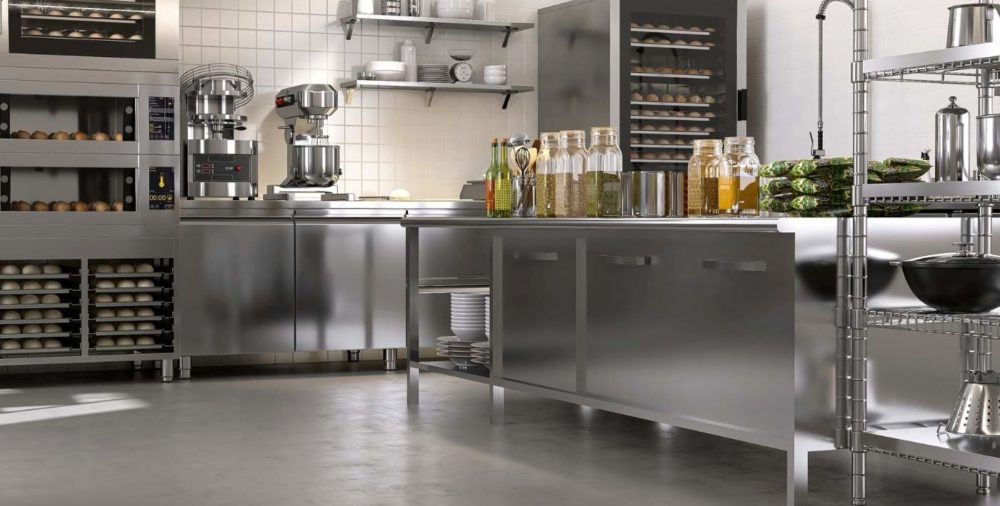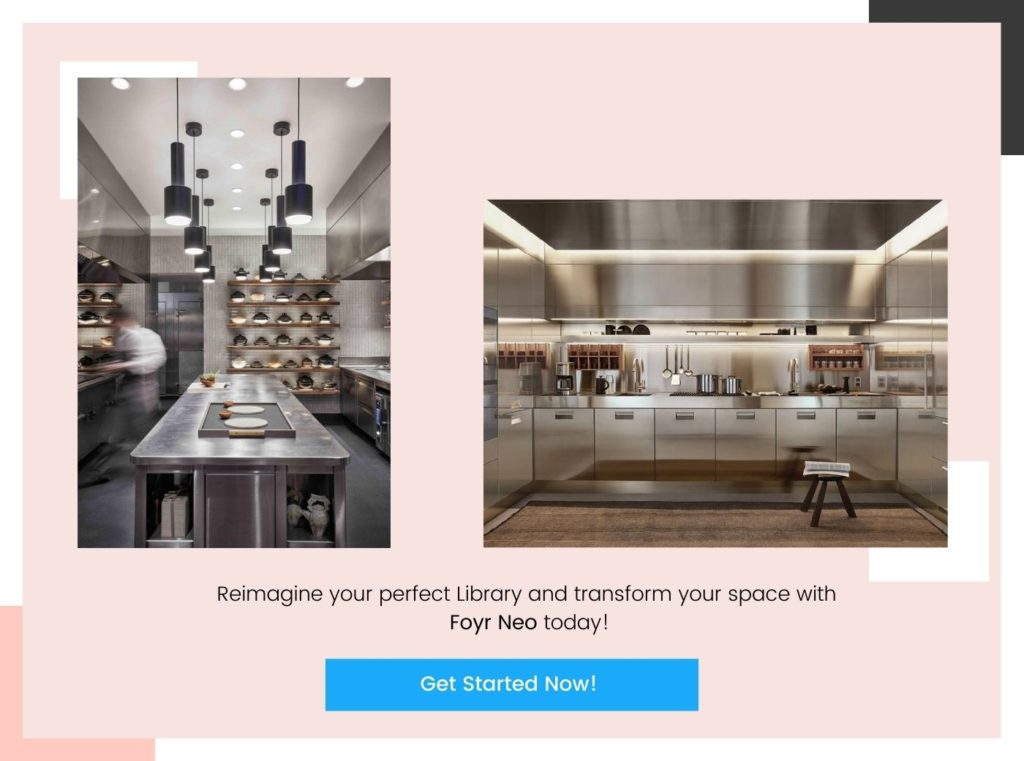Table of Contents
What is a Commercial Kitchen?
A commercial kitchen is a professional space specifically designed for the preparation and cooking of food, typically found in restaurants, catering services, and other foodservice establishments. These kitchens are engineered for efficiency and safety, featuring dedicated areas for food preparation, cooking, baking, dishwashing, and storage. A well-planned commercial kitchen layout enhances workflow, minimizes cross-traffic, and ensures a smooth transition from raw ingredients to final dishes, ultimately impacting the dining experience.
At Foyr, we specialize in delivering exceptional kitchen design services tailored to meet the unique needs of our clients. Our team understands that a well-designed commercial kitchen not only boosts operational efficiency but also enhances the culinary experience. We work closely with our clients to develop customized layouts that align with their vision, menu requirements, and regulatory standards. By utilizing advanced interior design software, we create innovative and state-of-the-art kitchen solutions that optimize space and functionality. Whether it’s a new kitchen build or a remodel, we are committed to outstanding customer service and excellence, ensuring every project is executed flawlessly. Allow us to help you create the heart of your restaurant with a commercial kitchen that inspires both chefs and diners alike.
Key Considerations for Kitchen Design
- Proper sanitation and safety measures, including compliance with health codes and food safety regulations, are crucial for the design of a commercial kitchen to protect both customers and staff.
- The layout of a restaurant kitchen significantly influences overall efficiency, as a well-designed kitchen can enhance workflow, minimize bottlenecks, and improve staff productivity.
- Incorporating features that facilitate supervision and training of kitchen staff, especially in larger facilities, is an important consideration for maintaining a productive and efficient kitchen environment.
Assessing Physical Space Requirements
- Proper lighting is essential in a commercial kitchen to ensure the safety of staff and the quality of food, with energy-efficient LED lights recommended for better illumination and longer lifespan.
- Space optimization is crucial for maximizing efficiency in a commercial kitchen layout, necessitating the close proximity of cooking, preparation, and storage areas to minimize unnecessary movement.
- The flooring in a commercial kitchen must be durable, slip-resistant, and easy to clean to maintain safety and hygiene standards.
- Every measurement within the kitchen—such as distances between light switches, doorways, and plumbing—plays an important role in meeting safety codes and should be accurately accounted for during design planning.
- Considering kitchen layout types, such as island or zone-style, impacts the overall organization and efficiency of work processes in a commercial kitchen.
Understanding Menu Specifications
- Understanding your menu is crucial because the design of your kitchen will depend on the type of food you plan to serve, influencing equipment choices and spatial arrangement.
- Your chef, who knows the menu best, should be consulted early in the design process to determine necessary storage, equipment, and kitchen size.
- Equipment and space arrangement in a commercial kitchen should be tailored to the specific menu items being prepared to enhance efficiency and workflow.
- Involving the foodservice team in the design process is important since they will have insights on the best configuration and equipment for the menu.
Complying with Local Health Codes
- Complying with local health codes ensures food safety and hygiene through proper separation of raw and cooked food areas and the incorporation of appropriate handwashing stations.
- It is essential to understand and adhere to the standards set by organizations like OSHA and the FDA regarding food storage, safety, preparation, and disposal.
- Obtaining necessary licenses and permits, such as a Certificate of Occupancy and Food Service License, is critical for compliance with local health regulations.
- A kitchen layout must be developed according to health codes, which may vary based on location, necessitating consultation with local inspectors.
- The layout should incorporate commercial-grade equipment that meets industry standards to align with health department codes and promote safe food handling practices.
Types of Commercial Kitchen Layouts
Foyr is an industry leader in interior design, specializing in innovative kitchen layouts tailored to various commercial needs. Our expertise encompasses all types of kitchen designs, including galley, open, island-style, and zone-style layouts, ensuring optimal efficiency and functionality for any culinary establishment. Here are some of them:
Assembly Line Design
- The assembly line kitchen layout is designed to optimize meal assembly for high-volume production, allowing food preparation to flow sequentially from one end to the other, culminating in a finished dish at the end of the line.
- This layout is particularly beneficial for kitchens that serve a large number of people quickly, making it suitable for settings like cafeterias or correctional facilities with a limited menu.
- In an assembly line configuration, kitchen equipment is arranged in a linear fashion, with the food preparation area at one end and the service area at the other to ensure swift food delivery.
- The cleaning and storage areas are typically placed behind the assembly line to minimize disruptions and maintain efficient flow and communication within the kitchen.
- While the assembly line layout improves speed and efficiency, it may restrict menu flexibility and result in lower food quality due to the focus on repetitive, high-volume tasks.
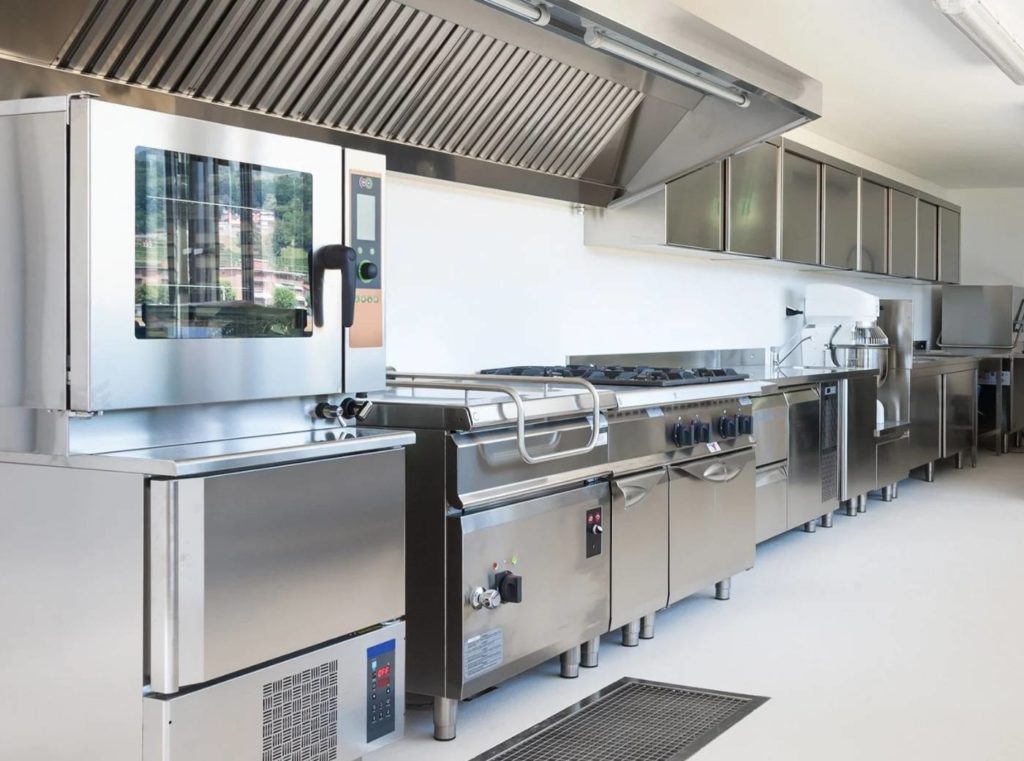
- The zone-style layout divides the kitchen into separate zones for each activity, such as food prep and dishwashing, facilitating specialization among the staff.
- This layout is particularly beneficial for restaurants with diverse menus, as it allows for the simultaneous preparation of various types of dishes.
- A zoning configuration enhances kitchen flow by leaving a wider open space in the center, promoting better movement among staff.
- Each zone in a zoning layout is equipped with the necessary tools and supplies, minimizing the time employees spend searching for equipment.
- While the zoning layout supports multi-tasking and efficient meal preparation, it also incurs higher initial and maintenance costs due to the need for specialized equipment in each zone.
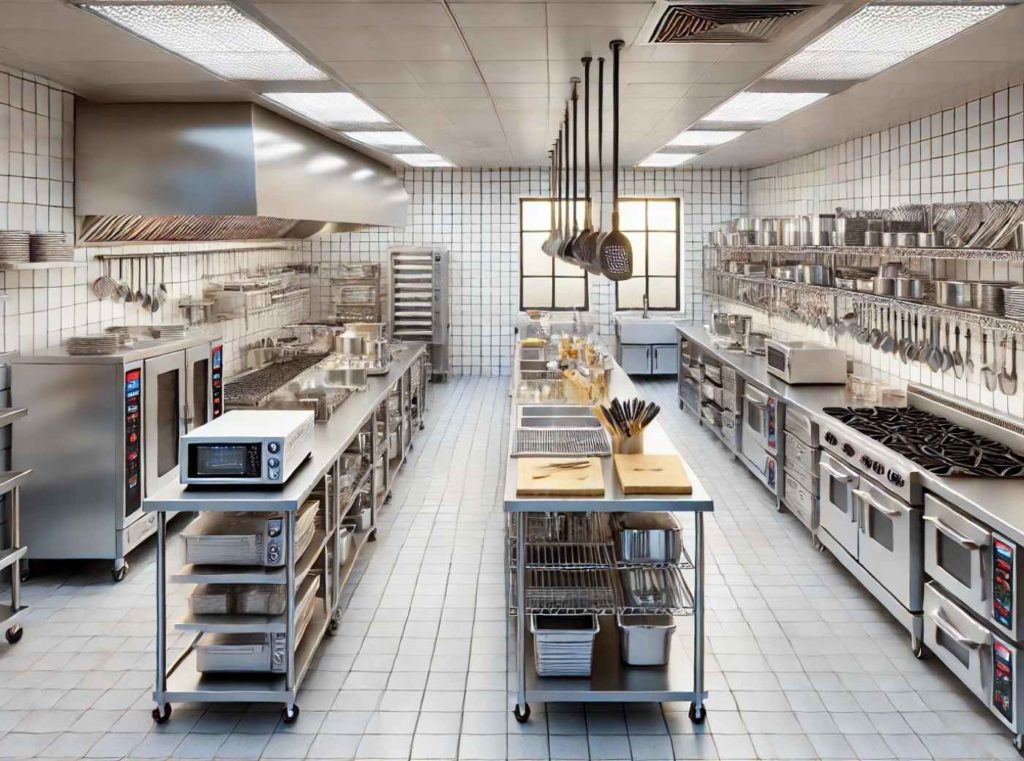
- A galley kitchen layout positions all stations and equipment along the perimeter of the kitchen, optimizing space in environments with limited square footage.
- This layout is ideal for smaller operational settings, such as food trucks or ghost kitchens, where efficient use of space is critical.
- In larger kitchens, a galley layout can feature a ring design that allows multiple cooks to rotate and cover various stations easily.
- The galley layout can lead to cramped conditions in parallel stations, significantly hindering productivity and increasing food prep times.
- Due to its design, the galley kitchen is generally not suitable for larger restaurant operations that require high volumes of food production.
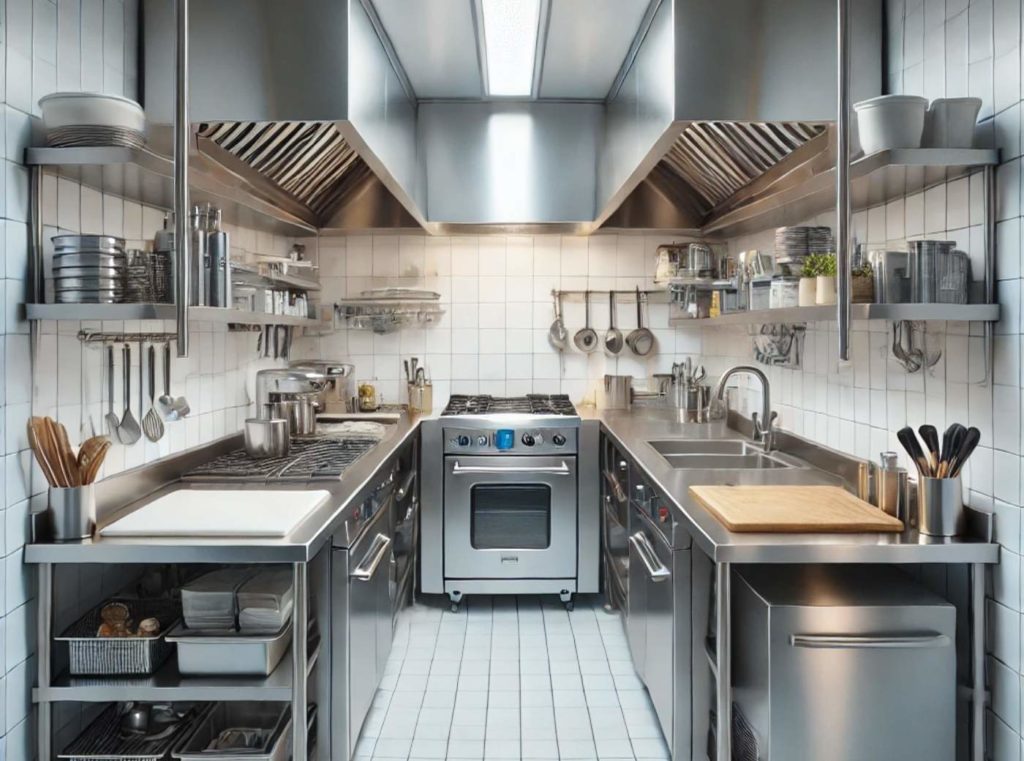
- The island layout positions major cooking equipment like ovens, ranges, and fryers centrally, promoting a circular flow in the kitchen design.
- This layout enhances communication and supervision among staff by congregating chefs around the central preparation area.
- An island kitchen layout is beneficial for larger kitchen spaces, allowing staff to move freely without obstruction.
- The configuration facilitates easier cleaning due to the open design and centralized equipment placement.
- The central “command center” in an island layout acts as a passthrough point for all meals, enhancing operational efficiency.
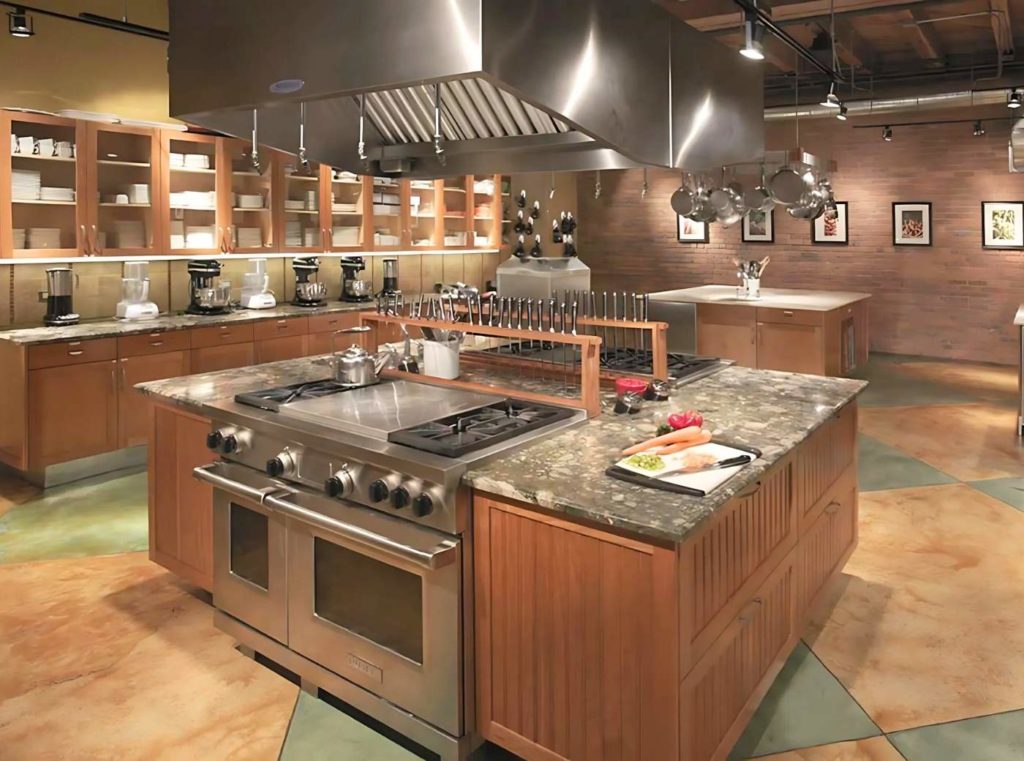
- An open kitchen layout allows customers to see the cooking process, contributing to a significant increase in customer satisfaction by 17.3% and faster service by 13.2%, according to a Harvard study.
- This kitchen design promotes a captivating atmosphere where diners can appreciate the artistry and skill involved in meal preparation.
- To enhance safety and comfort, it is recommended to position hot cooking equipment as far away from customers as feasible, and the installation of glass partitions may be beneficial in some scenarios.
- While an open kitchen layout adds an engaging element to the dining experience, it can also present challenges such as noise distractions and potential odors affecting the meal ambiance.
- This design is particularly suited for restaurant types that emphasize spectacle in their cooking style, allowing for an intimate dining experience while maximizing available space.
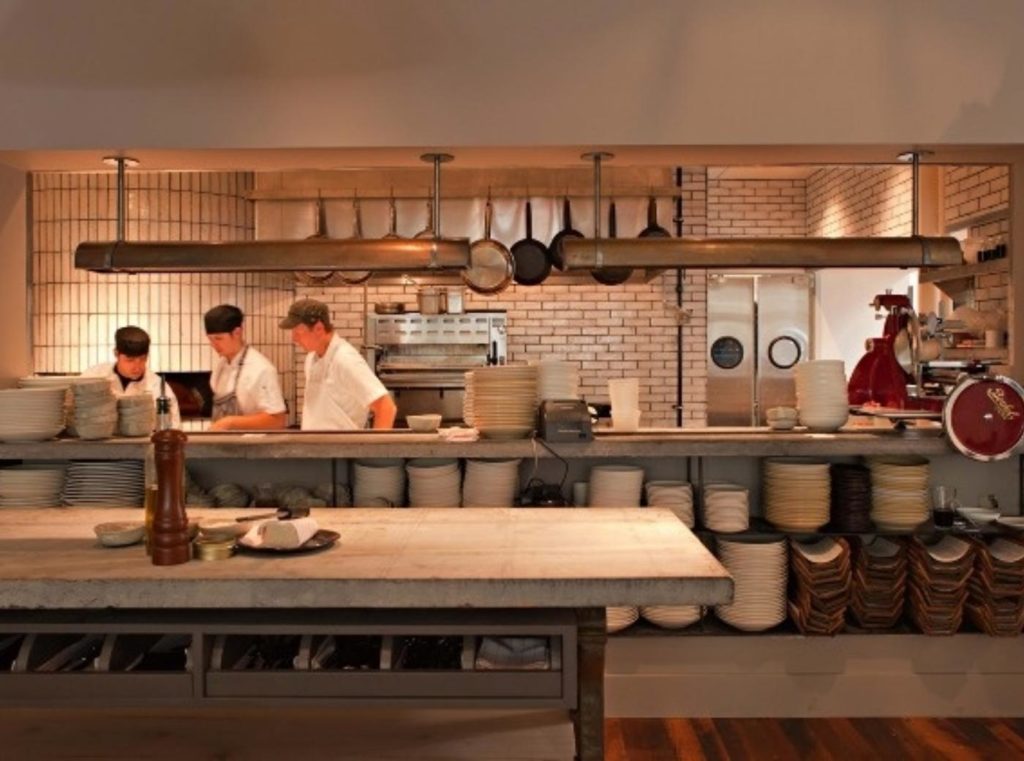
- Selecting the right commercial kitchen equipment is crucial as it greatly impacts the kitchens design and affects available space for food preparation tasks.
- Key equipment considerations include refrigerators, freezers, ovens, ranges, dishwashers, and specialized tools like food processors and mixers, tailored to the specific needs of the menu.
- A well-thought-out equipment selection enhances workflow optimization by ensuring that all kitchen staff can easily access the tools needed for their tasks.
- The layout of equipment should be arranged logically to minimize movement, optimize workflow, and ensure seamless transitions during food preparation.
- Effective storage solutions, such as walk-in coolers and dry storage spaces, are essential for maintaining efficiency, safety, cleanliness, and overall kitchen performance.
Importance of Choosing Quality Appliances
- Selecting quality appliances is crucial for ensuring energy efficiency in commercial kitchens, as proper arrangement of space and equipment can significantly lower operational costs.
- Essential appliances such as refrigerators, ovens, and dishwashers must be strategically placed near electrical outlets and in coordination with other equipment to optimize workflow and efficiency.
- Investing in energy-efficient appliances, like ENERGY STAR-rated units, not only reduces the kitchen’s carbon footprint but also leads to long-term savings on energy bills.
- The durability and ease of cleaning of kitchen appliances contribute to the overall hygiene and safety of food preparation areas, which is vital in any foodservice operation.
- Quality appliances, such as programmable ovens and smart refrigeration units, can enhance productivity by streamlining the cooking process and reducing waste through monitoring systems.
Addressing Space and Utility Requirements
- Space optimization is fundamental in commercial kitchen planning, with the layout designed to maximize efficiency and reduce unnecessary movement among staff.
- The cooking area should be equipped with necessary appliances and ample space, allowing chefs to work comfortably and efficiently.
- Preparation areas should be strategically located near cooking zones to facilitate easy transfer of ingredients, thereby minimizing food preparation time.
- Convenient positioning of storage areas next to cooking and preparation zones enables quick access to ingredients and supplies, enhancing overall kitchen workflow.
- A commercial kitchen layout must be optimized for the team, ensuring that only essential equipment is included to maximize space and efficiency.
Ensuring Regulatory Compliance
- Proper design of a commercial kitchen layout must prioritize adherence to local health codes and food safety regulations to ensure safety and sanitation during food preparation and service.
- Compliance with regulations may require specific guidelines for the placement of food prep areas in relation to waste disposal stations and the location of handwashing stations within the kitchen.
- Obtaining necessary licenses and permits, such as a Certificate of Occupancy (COO), Food Service License, and Food Handling Permit, is essential to operate a commercial kitchen legally.
- The kitchen layout must meet commercial kitchen code requirements, failing which could render the design irrelevant despite other functional considerations.
- Proper supervision and training of staff are critical elements of maintaining compliance with operational standards in a commercial kitchen, ensuring that staff adhere to best practices in hygiene and safety.









